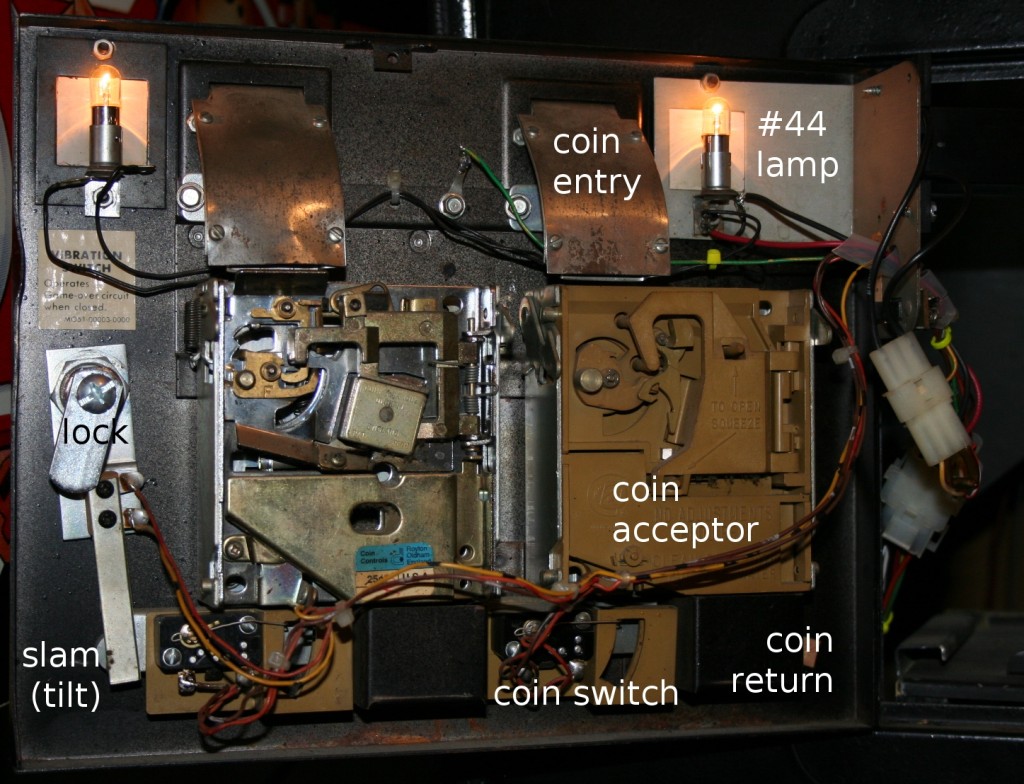or, a field guide to the identification and repair of the North American coin door
The coin door is the first part of a coin-operated game the player interacts with. They also protect the money. They take a lot of use and abuse, and no game looks good with one that is beat up. When I started collecting, I had a hard time figuring out which trim pieces to get to fix my damaged coin doors. I learned a lot from talking to Chris Kuntz, the Pinball Pirate, and eventually I realized I had to write some of it down. So, here it is, such as it is.
This is a guide to coin doors so you can figure out what parts to buy or scavenge. If you have an arcade game and you want to restore the coin door, perhaps this guide is for you.
Which door do I have?
See if any of these look close.
Before about 1980, manufacturers used their own doors almost exclusively. If you have a Gottlieb game, you have a Gottlieb door. After 1980, though, manufacturers started outsourcing doors, and they can be somewhat hard to distinguish, particularly Coinco and Coin Controls.
This page doesn’t cover many things prior to about 1975; I just don’t know much about those types of games.
Anatomy

Coins come in the coin entry, go through the coin acceptor which can tell a quarter from a washer, and then triggers the coin switch as it falls into the cash box; or, if there’s something wrong with the coin, it gets dropped in the coin return.
Most coin doors on pinball machines have a slam tilt switch. Many video games have this as well. On Midway games, this is attached to the lock.
Coin acceptors (aka “coin mechs“) are essentially a universal part and can actually be swapped between doors. Locks are pretty well standardized, and coin doors all seem to take a 7/8″ lock with a straight cam. Everything else isn’t so consistent.
Styles of doors
Two main styles of doors are available, and within a product line, tend to share parts. These are:
- over/under: exclusively video, these are the tall, skinny, two-door doors
- pinball: doors that fit pinball machines, but were also used on video; these are the squarish, or fat rectangular doors
Doors Made by the Game Manufacturers
All manufacturers made their own doors up into the ’80s when they switched to OEM doors.
- Atari
- Bally
- Chicago Coin
- Gottlieb’s big 1976 door replaced the 1962 door
- Midway (also appeared on late Bally games)
- Stern Electronics (not DE/Sega/Stern)
- Williams
Some companies never made their own doors, including Data East, Sega, Stern Pinball (distinct from Stern Electronics), and Premier (the successor to Gottlieb).
Doors from OEMs
- Coinco
- Coin Controls aka Wells-Gardner
- Entropy International
- Happ aka Suzo-Happ
Foreign Coin Doors
See Non-American Coin Doors (a work in progress).
How can I find parts?
Good luck, take a look at the parts page. Coin mechanisms are essentially universal (as are locks) but nothing else is interchangeable. Check the specific door page for advice, but if that fails, check eBay or make friends with an operator and try and scavenge from them.
Old doors have lots of parts!
Other Notes
Kyle Spiteri (previously of Pinball Pirate and Marco Pinball, currently of Stern Pinball) tells me that Data East used different harnesses and different doors at different times. This paragraph serves as a reminder to Kyle to send me more information. Hi, Kyle.
[…] Coin Door ID Guide […]